Irregular rainfall that interrupted the planting schedule for this season has made most maize farmers in Elgeyo Marakwet opt to cultivate drought resistant crops.
Some farmers who were forced to uproot withered maize crops from their farms and plant beans and other crops for domestic consumption, have opted to plant the ‘Katumani’ maize variety, which is known for its resistance to drought.
These farmers are also shifting to cultivation of finger millet and sorghum, as a way of minimizing losses.
“Unpredictable rainfall adds affliction and distress to the high prices of production, the only viable solution is to cultivate drought resistant crops,” said Almond Kipnamta, from Chebara, Marakwet West Sub-county.
Many farmers in Elgeyo Marakwet planted their crop in April as is the norm, but there was poor germination, which was attributed to inconsistent rainfall.
Farmers have also expressed their worry over low yield, due to the outbreak of Maize Lethal Necrosis that affected parts of the County, forcing them to uproot their crop.
“The attack of the disease to our crops poses a serious threat and challenge, to the cultivation of maize,” said Geldine Komen from Kapsowar, Marakwet West Sub-county.
The anticipation of low yield has driven farmers to switch and pursue the cultivation of neglected crops which are short term, for food security and as a source of sustainable and stable income.
“Although sorghum and finger millet require more labor, they enjoy a stable market price as compared to maize, beans or potatoes,” said Peter Kipkemoi from Chebororwa, Marakwet West Sub-county.
A 90-kg bag of finger millet is retailing at Sh7, 650 and that of sorghum goes for Sh5, 400 this makes more farmers to consider them as attractive, compared to the prices of maize which fluctuate and are determined by demand and supply drive.
Sorghum production in the County has increased and over 20,000 hectares of land is under the cultivation of the crop.
This is attributed to the availability of certified seed and a ready market.
By Rennish Okong’o





